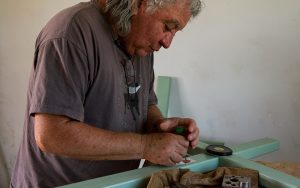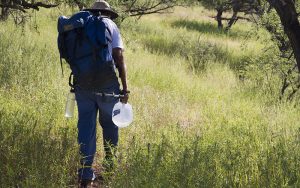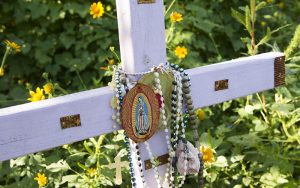TUCSON — Artist Alvaro Enciso lives on the Northeast side of Tumamoc Hill in a house full of art, including three-foot white crosses created to deliver a deeper message about death.
“The Sonoran Desert has a secret,” the artist said. “Not very many people know about 3,000 casualties here, 2,000 people missing.”
Enciso’s art is inspired by the Pima County Medical Examiner’s red-dotted “death map,” which marks the locations of bodies recovered near the border — all of them migrants who attempted to cross into Arizona. His work, which he calls “The Red Dots,” is meant to convey the tragedies of the desert.
Every Tuesday, Enciso takes four handmade crosses out to the desert and places them where migrant bodies were found. With a group of volunteers, Enciso digs a hole, pours cement and places the cross. Many of the dead are never identified.

Tucson artist Alvaro Enciso builds one of his handmade crosses to place in the desert. Each one marked with a single red to represent death. (Photo by Chelsea Rae Ybanez/Cronkite News)
“I tell the people this person is unidentified, and the people tend to get disappointed. They want to find a name. The saddest cases are the ones unidentified because there is no closure here,” Enciso said.
Each year, the Pima County Medical Examiner receives hundreds of remains from the Sonoran Desert believed to be undocumented border crossers. Since 2001, the office has received 2,728 bodies, with nearly one third still unidentified. This year alone, the medical examiner’s office has received 113 human remains.
Fifty percent of the remains are found by the U.S. Customs and Border Protection, while the rest are found by hikers, hunters or humanitarian groups, said Pima County Chief Medical Examiner Gregory Hess. Whether the remains can be identified depends on how long they’ve been in the desert.
“The odds of us identifying someone are directly proportional to the condition of the remains. If we have someone who is in good condition, that means they died a very short time ago,” Hess said.
Dry desert heat, insects, and animals cause bodies to rapidly decompose, making it harder to identify them or determine the cause of death.
“Someone dies outside and they are in a remote area, and their remains are not protected from the elements or from animal and insect activity, they may become nearly skeletal remains within three or four weeks,” Hess said.
Last year, 94 remains never were identified and in 110 cases, a cause of death could not be determined. Without defining characteristics like DNA, a history of dental work, tattoos, fingerprints or scars, the body may never be identified.
Hess said a majority of the remains belong to Mexican migrants, with some coming from El Salvador, Guatemala and Honduras.
The office attempts to compare the profile of the remains to international missing persons reports collected by the Consulate of Mexico, Guatemala, El Salvador as well as the Argentine Forensic Anthropology Team, according to a report from the International Organization of Migration. However, the IOM says the Colibri Center for Human Rights obtains the most comprehensive database for missing migrants, which shows more than 2,300 are still missing.
If bodies are not claimed, they are cremated and stored at the Pima County Cemetery. More than 800 unidentified remains were recorded at the cemetery in 2015.
That’s what bothers artist Enciso the most.
“This person is missing. How long will the wife of this missing, unidentified person wait before she can resume,” Enciso said. “I’m trying to give these people a little bit of identity by paying attention to this particular death.”
Enciso saw the migrant death map for the first time in 2012 and was moved by the red dots of death that covered the desert. He also collects remnants left behind by the migrants, like empty and rusted tuna cans. He turns them into art — small squares of metal, cut, painted and pieced together.
“There is a story told somewhere and this is what I’m trying to gather,” he said.
The deaths started to increase in 1999 after Operation Safeguard was implemented in Tucson, part of national plan to prevent illegal entry and drug smuggling across the border. Increased patrols in urban areas forced migrants to venture deeper into the desert, according to report by the American Civil Liberties Union in 2009.
The ACLU cited the Tohono O’odham Reservation as the deadliest migrant trail in the United States.

Bob Turnbull, A Tucson Samaritan Volunteer, hikes through the rough terrain on migrant trails in the Sonoran Desert. (Photo by Chelsea Rae Ybanez/ Cronkite News)
Pima County received an average of 14 migrant remains a year before Operation Safeguard was enforced, according to the ACLU report. After 2001, the office received an average 169 human remains recovered in the desert, with a record of 222 remains found in 2010.
The numbers of bodies motivated humanitarian groups like the Tucson Samaritans to provide aid by leaving gallon jugs of water for traveling migrants. The work it started in 2000 continues today with hikes through migrant trails leaving water, food, blankets or medical supplies.
“People are dying in the desert because they don’t have water, because they are being forced into dangerous areas because of policies. Because of a lack of a comprehensive immigration policy,” said Norma Price, a former physician and volunteer.
As migrants ventured deeper into the desert, more bodies were found.
“The remains that are found may not represent all the deaths. They are just the remains that have been located by various individuals,” Hess said. “There are a number of people that likely have not been found, but nobody really knows how many.”
The U.S. Border Patrol Southwest Sector has tracked nearly 7,000 deaths in the desert since 1998. However, weather and animals can scatter the remains with some never being found.
Bob Turnbull, a volunteer with Tucson Samaritans for 15 years, said he has noticed fewer deaths. A former University of Arizona professor has partnered with humanitarian aid groups to track migrant trails on a GPS map. The map provides information about the trails used by migrants, allowing strategic placement of water and aid.
“We have at least decreased the deaths in the areas that we serve,” Turnbull said. “We see where we had 10 jugs last week and five are empty, we feel good about that.”
Turnbull collected and counted the number empty jugs found at the water drop locations about a half-mile away from the nearest dirt road. Back at the red Toyota 4Runner, he opens a binder to write in the number of water jugs left at each location and the number of empty cartons found. The binder keeps track of what trails are being used by migrants.

A wooden cross from Alvaro Enciso was placed on the side of Arivaca Road for a baby that died. (Photo by Chelsea Rae Ybanez/Cronkite News)
On his trek back from the border trails, he passes a white cross. A rosary hangs from the top and toys surrounding the base. The cross was placed there by Tucson artist Enciso for a child found on the side of the road.
Enciso remembers it well.
“It broke my heart. This baby was born by the side of the road and died on that road,” Enciso said. “So, I put a cross there, and people learned that this was a baby that never had a chance.”
